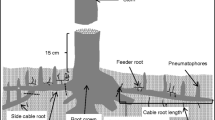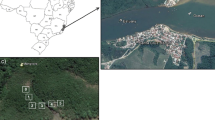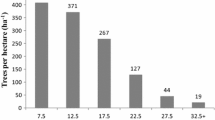Abstract
A review of studies on belowground biomass (BGB) of mangroves revealed that procedures for excavation and determination of dry weight are insufficiently documented. The main objective of this study was therefore to describe procedures for quantification of tree BGB for Avicennia marina (Forssk.), Sonneratia alba J. Smith and Rhizophora mucronata Lam. The study covered four sites in Tanzania where 30 trees were sampled (10 for each species). A new root sampling procedure applied for A. marina and S. alba seemed to work adequately. Dry to fresh weight ratios (DF-ratios) varied between tree species, between tree sizes and between root components. Therefore, for each tree species, tree- and root component-specific DF-ratios were applied for dry weight determination. For A. marina and S. alba trees, a significant proportion of total tree BGB is stored in the root crown (34 and 10 % respectively). Future studies should therefore ensure inclusion of root crown when accounting for total tree BGB. Tests of previously developed models on our data revealed large prediction errors, partly due to differences in site conditions and partly due to incomprehensive excavation procedures applied when these models were developed. Local tree BGB models for mangroves should therefore be developed.





Similar content being viewed by others
References
Ball MC, Pidsley SM (1995) Growth responses to salinity in relation to distribution of two mangrove species, Sonneratia alba and S. lanceolata, in northern Australia. Funct Ecol 9(1):77–85
Brown S (1997) Estimating biomass change of tropical forests: primer. FAO forestry paper 134. FAO, Rome
Chave J, Andalo C, Brown S, Cairns MA, Chambers JQ, Eamus D, Folster H, Fromard F, Higuchi N, Kira T, Lescure JP, Nelson BW, Ogawa H, Puig H, Rie´ra B, Yamakura T (2005) Tree allometry and improved estimation of carbon stocks and balance in tropical forests. Oecologia 145:87–99
Chave J, Coomes DA, Jansen S, Lewis SL, Swenson NG, Zanne AE (2009) Towards a worldwide wood economics spectrum. Ecol Lett 12:351–366
Chave J, Réjou-Méchain M, Búrquez A, Chidumayo E, Colgan MS, Delitti WBC, Duque A, Eid T, Fearnside PM, Goodman RC, Henry M, Martínez-Yrízar A, Mugasha WA, Muller-Landau HC, Mencuccini M, Nelson BW, Ngomanda A, Nogueira EM, Ortiz-Malavassi E, Pélissier R, Ploton P, Ryan CM, Saldarriaga JG, Vieilledent G (2014) Improved allometric models to estimate the aboveground biomass of tropical forests. Glob Chang Biol 20:3177–3190
Clough BF, Dixon P, Dalhaus O (1997) Allometric relationships for estimating biomass in multi-stemmed mangrove trees. Aust J Bot 45:1023–1031
Cohen R, Kairo J, Okello JA, Bosire JO, Kairo JG, Huxham M, Mencuccine M (2013) Propagating uncertainty to estimates of above-ground biomass for Kenyan mangroves: a scaling procedure from tree to landscape level. For Ecol Manag 310:968–982
Comley BWT, McGuinness KA (2005) Above- and below-ground biomass, and allometry of four common northern Australian mangroves. Aust J Bot 53:431–436
Crawley MJ (2007) The R book. Wiley, Chichester
Dahdouh-Guebas F, De Bondt R, Abeysinghe PD, Kairo JG, Cannicci S, Triest L, Koedam N (2004) Comparative study of the disjunct zonation pattern of the grey mangrove Avicennia Marina (Forsk.)Vierh. In Gazi Bay (Kenya). Bull Mar Sci 74:237–252
Donato DC, Kauffman JB, Murdiyarso D, Kurnianto S, Stidham M, Kanninen M (2011) Mangroves among the most carbon-rich forests in the tropics. Nat Geosci 4:293–297
Food and Agriculture Organization of the United Nations (FAO) (2007) The World’s mangroves 1980–2005. FAO forestry paper 153. FAO, Rome
Hirata Y, Tabuchi R, Patanaponpaiboon P, Poungparn S, Yoneda R, Fujioka Y (2014) Estimation of aboveground biomass in mangrove forests using high-resolution satellite data. J For Res 19:34–41
Hutchings P, Saenger P (1987) Ecology of mangroves. University of Queensland Press, Brisbone, p 388
IPCC (2006) Guidelines for national greenhouse gas inventories. Vol. 4: agriculture, forestry and other landuse. In: Eggleston HS, Buendia L, Miwa K, Ngara T, Tanabe K (eds) IPCC, Inter-governmental panel on climate change (IPCC). IPCC/IGES, Hayama
IPCC (2013) Revised supplementary methods and good practice guidance arising from the Kyoto protocol. In: Irving W, Zhou L (eds) Inter-governmental panel on climate change (IPCC). IPCC/IGES.3, Stockholm
Joshi H, Ghose M (2003) Forest structure and species distribution along soil salinity and pH gradient in mangrove swamps of the Sundarbans. Trop Ecol 44(2):197–206
Kairo JG, Joseph KSL, Dahdouh-Guebas F, Bosire J, Karachi M (2008) Structural development and productivity of replanted mangrove plantations in Kenya. For Ecol Manag 255:2670–2677
Kairo JG, Bosire J, Langat J, Kirui B, Koedam N (2009) Allometry and biomass distribution in replanted mangrove plantations at Gazi Bay, Kenya. Aquat Conserv 19:S63–S69
Kauffman JB, Donato DC (2012) Protocols for the measurement, monitoring and reporting of structure, biomass and carbon stocks in mangrove forests. Working paper 86. CIFOR, Bogor
Kauffman JB, Heider C, Cole T, Dwire KA, Donato DC (2011) Ecosystem Carbon stocks of Micronesian mangrove forests: implications of land use and climate change. Wetlands 31:343–352
Kirui B, Kairo JG, Karachi M (2006) Allometric equations for estimating aboveground biomass of Rhizophora mucronata mangroves at Gazi Bay Kenya. WIOJMS5 5(1):27–34
Komiyama A, Ogino K, Akisornkoae S, Sabhasri S (1987) Root biomass of a mangrove forest in Southern Thailand 1. Estimation by trench method and the zonal structure of root biomass. J Trop Ecol 3:97–108
Komiyama A, Havanond S, Srisawatt W, Mochida Y, Fujimoto K, Ohnishi T, Ishihara S, Miyagi T (2000) Top/root biomass ratio of a secondary mangrove (Ceriops tagal (Perr.) C.B. Rob.) forest. For Ecol Manag 39:127–134
Komiyama A, Poungparn S, Kato S (2005) Common allometric equations for estimating the tree weight of mangroves. J Trop Ecol 21:471–477
Komiyama A, Ong JE, Poungparn S (2008) Allometry, biomass, and productivity of mangrove forests: a review. Aquat Bot 89:128–137
Lang’at JKS, Kirui BKY, Skov MW, Kairo JG, Mencuccini M, Huxham M (2013) Species mixing boosts root yield in mangrove trees. Oecologia 172:271–278
Lovelock CE, Feller IC, McKee KL, Thompson R (2005) Variation in mangrove forest structure and sediment characteristics in Bocas del Toro, Panama. Caribb J Sci 41(3):456–464
Luoga EJ, Malimbwi RE, Kajembe GC, Zahabu E, Shemwetta DTK, Lyimo-Macha J Mtakwa P Mwaipopo CS (2004) Tree species composition and structures of Jasini Mwajuni Mangrove forest at Pangani, Tanzania. J TAF10: 42–47
Mattia SB (1997) Species and structural composition of natural mangrove forests: a case study of the Rufiji delta. Tanzania. Dissertation for award of MSc. Degree at Sokoine University of Agriculture, Morogoro, Tanzania
MNRT (Ministry of Natural Resources and Tourism) (1991) Management plan for the mangrove ecosystem of Rufiji District, mainland Tanzania, vol 7. Ministry of Tourism, Natural Resources and Environment (MTNRE), Forestry and Beekeeping Division, Catchment Forestry Project, Dar es Salaam
Mugasha WA, Eid T, Bollandsås OM, Malimbwi RE, Chamshama SAO, Zahabu E, Katani JZ (2013) Allometric models for prediction of above- and belowground biomass of trees in the miombo woodlands of Tanzania. Forest Ecol Manag 310:87–101
Murdiyarso D, Donato DC, Kauffman JB, Stidham M, Kurnianto S, Kanninen M (2009) Carbon storage in mangrove and peatland ecosystems in Indonesia—a preliminary account from plots in Indonesia. Working paper 48. Center for International Forest Research, Bogor
Niklas KJ (2004) Plant allometry: is there a ground unifying theory? Biol Rev 79:871–889
Nock CA, Geihofer D, Grabner M, Baker PJ, Bunyavejchewin S, Hietz P (2009) Wood density and its radial variation in six canopy tree species differing in shade-tolerance in western Thailand. Ann Bot 104:297–306
Nshare JS, Chitiki A, Malimbwi RE, Kinana BM, Zahabu E (2007) The current status of the mangrove forest along seashore at Salenda bridge, Dar es Salaam, Tanzania. J TAF 11:172–179
Ong JE, Gong WK, Wong CH (2004) Allometry and partitioning of the mangrove, Rhizophora apiculata. For Ecol Manag 88:395–408
Purnobasuki H (2013) Characteristics of root caps in four root types of Avicennia marina (Forsk.) Vierh. Am J P Sci 4:853–858
Richmond MD (ed) (1997) A guide to the sea shores of Eastern Africa and the Western Indian Ocean islands. Sida Department for Research Cooperation, SAREC, Stockholm
R Core Team (2013) R: a language and environment for statistical computing. R Foundation for Statistical Computing, Vienna. http://www.R-project.org/. Accessed 20 Nov 2013
Santini NS, Schmitz N, Lovelock CE (2012) Variation in wood density and anatomy in a widespread mangrove species. Trees 26:1555–1563
Sitoe AA, Mandlate LJC, Guedes BS (2014) Biomass and carbon stocks of Sofala Bay mangrove forests. Forests 5:1967–1981
Slim FJ, Gwada PM, Kodjo M, Hemminga MA (1996) Biomass and litterfall of Ceriops tagal and Rhizophora mucronata in the mangrove forest of Gazi Bay, Kenya. Mar Freshw Res 47:999–1007
Spalding M, Kainuma M, Collings L (2010) World atlas of mangroves. A collaborative project of ITTO, ISME, FAO, UNEP-WCMC, UNESCO-MAB, UNU-INWEH and TNC. Earthscan, London, p 319
Steinke TD, Ward CJ, Rajh A (1995) Forest structure and biomass of mangroves in the Mgeni estuary, South Africa. Hydrobiologia 295:159–166
Tam NFY, Wong YS, Lan CY, Chen GZ (1995) Community structure and standing crop biomass of a mangrove forest in Futian Nature Reserve, Shenzhen, China. Hydrobiologia 295:193–201
Tamai S, Nakasuga T, Tabuchi R, Ogino K (1986) Standing biomass of mangrove forests in southern Thailand. J Jpn For Soc 68:384–388
Tamooh F, Huxhamd M, Karachi M, Mencuccini M, Kairo JG, Kirui B (2008) Below-ground root yield and distribution in natural and replanted mangrove forests at Gazi Bay, Kenya. For Ecol Manag 256:1290–1297
United Republic of Tanzania (URT) (2010) National forest resources monitoring and assessment of Tanzania (NAFORMA). Field manual. Biophysical survey. NAFORMA document M01 – 2010, p 108
Valiela I, Bowen JL, York JK (2001) Mangrove forests: one of the world’s threatened major tropical environments. Bioscience 51(10):807–815
Wang Y, Bonynge G, Nugranad J, Traber M, Ngusaru A, Tobey J, Hale L, Bowen R, Makota V (2003) Remote sensing of mangrove change along the Tanzania coast. Mar Geod 26:1–14
Wannasiri W, Nagai M, Honda K, Santitamnont P, Miphokasap P (2013) Extraction of mangrove biophysical parameters using airborne LiDAR. Remote Sens 5:1787–1808
Zanne AE, Lopez-Gonzalez G, Coomes DA, Ilic J, Jansen S, Lewis SL, Miller RB, Swenson NG, Wiemann MC, Chave J (2009) Global wood density database. Dryad. Identifier: http://hdl.handle.net/10255/dryad.235. Accessed 15 Dec 2013
Acknowledgments
This research work was financed by the Climate Change Impacts and Adaptation Mitigation (CCIAM) Programme under the cooperation between the Government of the United Republic of Tanzania and the Government of the Kingdom of Norway. We are also grateful for supplementary funding by the Project “Enhancing the Measuring, Reporting and Verification (MRV) of forests in Tanzania”. Besides we are indebted to D. Mnyagi (Pangani), S.K. Nyabange (Bagamoyo), H. Mallya (Rufiji) and M.C. Mbago (Mtwara), working for Tanzania Forest Service, for logistical support during field work. The field assistants including boat drivers are also acknowledged for their hard work and courage throughout an intensive and tiresome data collection. The anonymous reviewers are appreciated for their valuable and critical comments.
Funding
The work reported here was financed by the CCIAM Programme and Enhancing the measuring, reporting and verification (MRV) of forests in Tanzania Project both under the cooperation between the Government of United Republic of Tanzania and the Kingdom of Norway.
Author information
Authors and Affiliations
Corresponding author
Rights and permissions
About this article
Cite this article
Njana, M.A., Eid, T., Zahabu, E. et al. Procedures for quantification of belowground biomass of three mangrove tree species. Wetlands Ecol Manage 23, 749–764 (2015). https://doi.org/10.1007/s11273-015-9417-3
Received:
Accepted:
Published:
Issue Date:
DOI: https://doi.org/10.1007/s11273-015-9417-3




